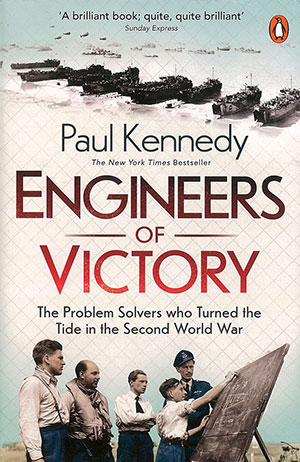Bryon Greenwald
Engineers of Victory Reviewed
24 îêòÿáðÿ 2014

Best-selling author and historian Paul Kennedy, the Dilworth Professor of History and Director of International Security Studies at Yale University, has written a stimulating book about the middle—the middle years of World War II, the middle or operational level of war, and the middlemen, problem-solvers, and midlevel commanders that made victory possible. In doing so, he focuses attention on a largely unexplored portion of the war’s history and provides professional historians and general readers a deeper understanding of how and why the Allies won World War II.
Much of the English-language history of World War II obscures or bypasses Kennedy’s “middle.” The war’s numerous general histories gloss over how the Allies solved their thorny operational problems, and the volumes recounting the war’s great strategic decisions or detailing its tactical maneuvering far outnumber studies of organizational, technological, or operational innovation in the middle. Moreover, few such studies delve as extensively into this critical middle world filled with a multitude of organizations, weapons and technology, Service and joint doctrines, and theater planning efforts that connect the lofty endstates and big ideas of statesmen to the vital combat action on the ground, in the air, and on and under the sea.
Paul Kennedy examines that middle ground in an easy yet erudite manner and explains in five information-filled and engaging chapters how the Allies solved the five operational tasks essential to victory: crossing the Atlantic, winning command of the air, stopping the Blitzkrieg, seizing an enemy-held shore, and defeating the “tyranny of distance.” Building on the excellent work of other historians, particularly the Military Effectiveness series by Allan R. Millett and Williamson Murray, Kennedy highlights who, what, where, when, why, and how the United States, United Kingdom, and Soviet Union achieved these tasks and defeated the Germans, Italians, and Japanese in a war fought on six of seven continents and most of the world’s oceans.
The majority of the book focuses on the middle years of the war, approximately the 18 months from the Casablanca Conference in January 1943 to the launching of the first B-29 bombing mission from Tinian on the day after Thanksgiving (November 24) 1944. As such, Kennedy analyzes the Allied transition from losing to winning in every domain of warfare (land, sea, and air) and every major theater of war—the Atlantic, North Africa, Russia, Northwest Europe, and the Pacific. His emphasis on the operational level of war as well as the organizational and technological innovations required to tip the balance is refreshing and long overdue.
Kennedy is a master of deconstructing problems into their discrete elements and discussing in detail the decisions and actions that solved them. For such an easy read, the book is intellectually dense. (Indeed, his footnotes, commentary, and bibliography are equally valuable.) One example should suffice to prove the norm.
Getting adequate quantities of fuel, weapons, munitions, troops, and foodstuffs to England was the first essential step toward the defeat of Germany. Appropriately, the book opens with a thorough discussion of how synergistic innovations in doctrine, technology, materiel, training, and leadership significantly reduced U-boat attacks on merchant shipping and won the Battle of the Atlantic. To put this struggle in perspective, U-boats sank 6.3 million of the 7.8 million tons of Allied merchant shipping lost in 1942, a total that virtually nullified the 7 million tons of shipping mass-produced in America that year. Left uncorrected, this strangulation meant that the Allies would never marshal sufficient supplies, weapons, and men in England to attack Germany and that the British people would most likely starve or freeze to death. Kennedy dissects this dilemma and deftly describes each problematic strand of this knotty challenge. He then adroitly details how the use of drop tanks, additional escort craft, and the development of miniaturized microwave radar and the deployment of Hedgehog antisubmarine munitions allowed the Allies to “find, fix, and finish” U-boats before most launched their deadly torpedoes. The rest of the book is equally compelling and illuminating.
Engineers of Victory is an important book that should encourage further study of World War II by all readers. Seventy-seven years after the war began (if one includes the 1937 Japanese attack into Manchuria), the middle remains a vast untapped area of historical inquiry. By necessity, Paul Kennedy only scratches the surface in explaining the key Allied operational-level questions of the war. In a fluid, well-researched, and insightful volume, he inspires us to ask and answer more questions about the problem-solvers, the “tweakers,” and the “culture of innovation” that enabled the Allied victory. JFQ
Âåðíóòüñÿ íàçàä